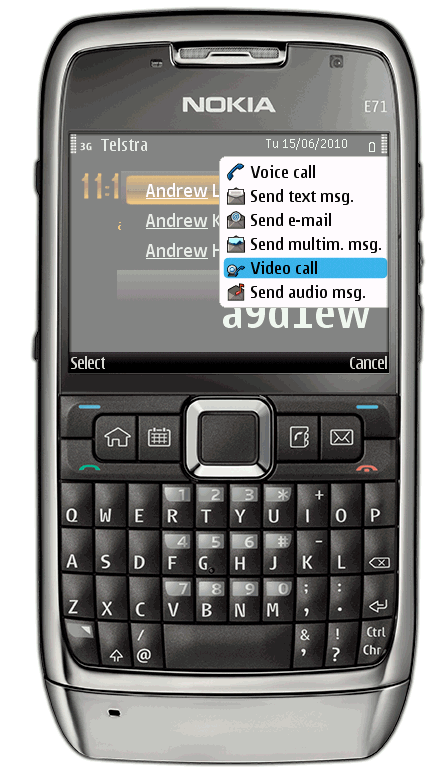Originally posted on 15Jun10 to IBM Developerworks (11,653 Views)

Since I penned my last post, I have done some more reading on Facetime and watch Steve Job’s launch of Facetime. While I will happily admit that Apple have in fact used some standards within their Facetime Technology (Jobs lists H.264, AAC, SIP, STUN, TURN, ICE, RTP, SRTP as all being used), I am somewhat bemused by the “standards” discussion that most of the media seem to be focusing on with regard to Facetime. Almost everyone that refers to compliance with standards is talking about interoperability with current PC based video chat capabilities – from the likes of Skype, MS Messenger, GTalk and others. Am I the only one that has noticed the iPhone 4 is not a PC and is in fact a mobile phone? Why is it that no one else is questioning interoperability with existing video chat capable mobile phones?
After thinking on this for a little while, I guess it might be that most of the media coverage about the iPhone 4 is coming from the USA – where is was launched. It’s only natural. The problem with the US telecoms market is that it is not representative of the rest of the world – who has had video calling for ages and don’t really use it. Perhaps it was the overflowing Apple coolaid fountain in the iPhone 4 launch that got the audience clapping when Jobs placed a video call, or perhaps it was just that they had never seen a video call before – I wasn’t there so I cant be sure. Right now, the Facetime capability on the iPhone 4 is only for WiFi connections – which makes it pretty limiting. Apparently, there is no setup required, no buddylist, you just use the phone number to make a video call – which is the way video calling already works (see the screen dump of my phone to the right and the short video below), but the WiFi limitation on the iPhone 4 will mean that you have to guess when the recipient is WiFi connected. At least with the standard 3GPP video call, the networks are ubiquitous enough to pretty much guarantee that if the recipient is connected to a network, they can receive a video or at least a phone call. Job’s didn’t explain what would happen if the recipient was not WiFi connected – does it just make a voice call instead? I hope so.
(Note: the original post had a flash video of a video call conducted from my Nokia e71 phone – I’m trying to find the original recording of the call (3GVideoCall/3GVideoCall_controller.swf) and I’ll update this post if I can find it)
If you look at the pixelation and general poor quality of the video call, consider that I am in a UMTS coverage area, not HSPA (the phone would indicate 3.5G if I were), so this is what was available more than seven years ago in Australia, longer in other countries. If I was in a HSDPA coverage area, I would expect the video call to be higher quality due to the increase bandwidth available.
I recall in 2003, Hutchison 3 launched their 3G network in Australia with much fan-fair. Video calls was a key part of the 3G launch in Australia for all of the telcos. This article from the 14Apr03 Sydney Morning Herald (on day before the first official 3G network in Australia) illustrates what I am talking about. The authors say that the network’s “…main feature is that it makes video calling possible via mobile phone.” Think about it for a second. That’s from more than seven years ago and Australia was far from the first country to get a 3G network. A lifetime in today’s technology evolution. Still the crowds clapped and cheered as Jobs made a Video call. If I had have been in the audience, I think I would have yawned at that point.
The other interesting thing that I noticed in job’s speech as his swipe at the Telcos. He implied that they needed to get their networks in order to support video calls. Evidence from the rest of the world would suggest that is not the case – perhaps it is in the USA, or perhaps he is trying to deflect blame for not allowing Facetime over 3G connections away from Apple and back to the likes of AT&T who have copped a lot of flack over their alleged influence on Apple’s Application store policies involving applications that could be seen to be competitive with services from AT&T. I am not sure how much stick AT&T deserve on that front, but it’s pretty obvious from job’s comment that he is not in love with carriers – and certainly from what I’ve seen, carriers are not in love with Apple. It might be interesting to see how long the relationship lasts. My guess is that as long as Apple devices continue to be popular, both parties will be forced to share the same bed.
On another related point, I have been searching the Internet to find what standards body Apple submitted Facetime to for certification – Jobs says in the launch that it will be done “tomorrow” – this could be marketing speak for ‘in the future’ or it could literally mean the day after he launched the iPhone 4. If anyone knows please let me know – I want to have a look into the way Facetime works.
Thanks very much to my colleague Geoff Nicholls for taking the Video Call in the video above.




